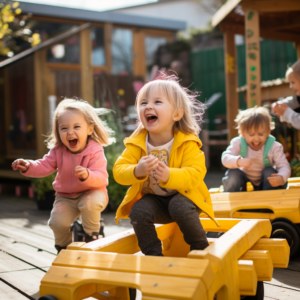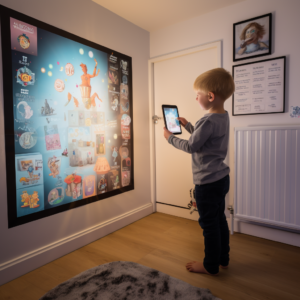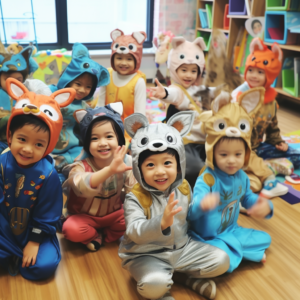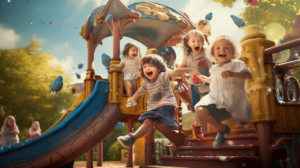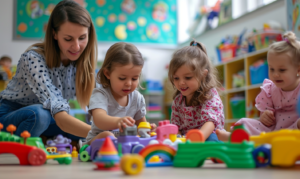Imagine a world where maths lessons are serenaded by Mozart, history is taught through haikus, and the ABCs come with a side of abstract art. This isn’t a scene from a whimsical fantasy film; it’s the heart of modern early education where music and arts play leading roles. In this article, we delve into how these creative activities are not just child’s play but vital cogs in the machinery of child development.
The Symphony of Learning: Music in Early Education
Let’s fine-tune our focus on music in early education, where every tap, beat, and melody plays a pivotal role in the orchestra of child development. Imagine a classroom, vibrant and buzzing with energy, where tiny tots are not just tapping tambourines and bashing drums, but also stringing together the building blocks of their future. This isn’t just an adorable cacophony; it’s a carefully orchestrated symphony of learning.
Music in the realm of early education is akin to that cool aunt who not only sneaks you sweets but also teaches you the secret recipes. It makes learning a delightful, engaging, and unforgettable experience. Far from being a mere background tune, music is at the forefront of educational strategies, harmonizing play with learning.
Case Study 1: The Mozart Effect in Action
Consider the case of Little Harmonies Preschool in Oxfordshire, where a unique program integrates classical music into everyday learning. The ‘Mozart Effect’ – a term coined from studies suggesting that listening to Mozart’s compositions may improve cognitive function – is put into practice here. Children start their day with a gentle Mozart symphony, and teachers report a notable increase in concentration and engagement levels. Through activities like identifying musical instruments in classical pieces, these young minds are not just enjoying music; they’re enhancing their auditory discrimination and memory skills.
Case Study 2: Rhythmic Mathematics
In the bustling city of Manchester, a primary school has taken a novel approach to teaching mathematics. By incorporating rhythmic patterns and musical notation into math lessons, they’ve created a ‘Rhythmic Mathematics’ program. Children learn fractions through musical beats and understand symmetry and patterns through dance movements. This innovative approach has resulted in a significant boost in children’s mathematical abilities and a newfound enthusiasm for a subject often perceived as challenging.
Expanding Language through Lyrics
Music’s impact on language development is profound. Engaging with songs, especially those with repetitive and rhyming lyrics, enhances vocabulary and language skills. In a nursery setting in Basingstoke, toddlers engage in ‘Lyric and Language’ sessions where they learn new words and concepts through song. This melodic method of teaching not only expands their vocabulary but also improves their pronunciation and comprehension abilities.
Fine-tuning Motor Skills with Music
Music also plays a crucial role in enhancing fine and gross motor skills. When children clap to a beat or move to the rhythm, they’re not just having fun; they’re developing coordination and rhythm. In a recent study conducted by the University of Cambridge, children who participated in regular musical activities showed significant improvement in hand-eye coordination and precision tasks compared to their peers who did not.
The role of music in early education is like a multifaceted gem, each facet reflecting a crucial aspect of child development. From enhancing mathematical abilities and language development to fine-tuning motor skills, music is an essential thread in the fabric of early learning. It’s a tool that not only educates but also inspires, creating a harmonious blend of learning and creativity. So, let’s keep the music playing in our classrooms, for it truly is the rhythm that guides the future steps of our little learners.
A Palette of Possibilities: The Arts in Child Development
Diving deeper into the vibrant world of the arts in early education, we find it’s more than just a canvas for young Picassos and Kahlos. It’s a dynamic space where every stroke, splatter, and sketch contributes to the holistic development of a child. The arts are indeed the unsung heroes of early education, offering a spectrum of opportunities for young minds to explore, express, and evolve.
In this colourful world, a simple dab of paint, a crayon drawing, or a clay model is more than just play. It’s a journey into self-expression, emotional understanding, and the development of crucial skills.
Case Study 1: Emotional Landscapes Through Art
At Sunnyvale Preschool in Surrey, a unique program encourages children to translate their emotions into art. By drawing or painting how they feel, children learn to articulate and process their emotions. A recent showcase titled “Emotional Landscapes” displayed artworks that ranged from vibrant, chaotic collages representing joy, to subdued, gentle watercolours symbolising sadness. This approach has not only nurtured emotional intelligence but also fostered empathy among peers.
Case Study 2: The Wonders of Waste Material Art
A primary school in Leeds has embarked on an eco-friendly art initiative, teaching children to create art from waste materials. This ‘Wonders of Waste’ program encourages creativity and innovation, as children learn to see the potential in everyday objects. From bottle cap mosaics to cardboard sculptures, these young environmental artists are learning about sustainability while developing their fine motor skills and spatial awareness.
Developing Fine Motor Skills Through Art
Art activities are instrumental in enhancing fine motor skills. The act of holding a paintbrush, cutting with scissors, or moulding clay strengthens hand muscles and improves dexterity. In a study conducted by the University of Birmingham, children who regularly participated in art activities showed more advanced fine motor skills than their peers who did not.
A World of Colours and Perspectives
In the arts, children learn to interpret and represent the world around them. A preschool in Bristol integrates multicultural art lessons, exposing children to various artistic traditions from around the globe. This not only broadens their artistic horizons but also fosters an appreciation for cultural diversity.
Innovating with Interactive Art
The integration of technology in art education has opened new avenues for creativity. An interactive art project in a London school uses digital tablets for children to create animations and digital paintings. This blend of art and technology cultivates digital literacy alongside artistic skills, preparing children for a tech-savvy future.
The role of the arts in child development is a kaleidoscope of endless possibilities. From fostering emotional intelligence and cultural awareness to developing fine motor skills and promoting sustainability, the arts enrich the educational experience in myriad ways. It’s a journey through a world where every colour, texture, and shape is a step towards nurturing well-rounded, creative, and emotionally intelligent individuals. The arts in early education are not just about creating art; they’re about crafting future thinkers, innovators, and empathetic citizens.
The Encore: Bringing It All Together
As we draw the curtain on this exploration of music and arts in early education, let’s envision a grand finale where these two disciplines harmonize to create an extraordinary symphony of learning. Combining music and arts in the educational mix is akin to orchestrating a splendid gala of creativity and expression, where every child holds a VIP invitation. It’s a revelry of imagination, a carnival of colours and sounds, celebrating the very essence of childhood learning.
This integration is not just about adding a splash of colour or a melody to the daily routine; it’s a strategic approach that intertwines various elements of learning into a cohesive, enriching experience. Educators who blend music and arts into their curriculum are akin to skilled conductors, harmonizing different instruments to create a masterpiece.
A Symphony of Senses
When music and arts converge in a classroom, they create a multisensory learning environment. This approach caters to various learning styles, ensuring that whether a child is an auditory, visual, or kinesthetic learner, there is something in the lesson that resonates with them. A classroom that hums with music and buzzes with art activities is a space where every child finds their rhythm and their canvas.
Fostering Collaboration and Communication
The amalgamation of music and arts also fosters essential life skills such as collaboration and communication. Group musical performances or art projects require children to work together, share ideas, and respect each other’s contributions. This collaborative environment nurtures teamwork and builds a sense of community among the young learners.
Case Study: The Harmony Project
Take, for example, the Harmony Project in a primary school in Liverpool. This initiative brings together music and visual arts in a year-long project culminating in a school-wide exhibition and performance. Throughout the year, children work on composing music and creating artworks that reflect a common theme. The project not only enhances their artistic and musical skills but also teaches them about project management, teamwork, and the beauty of bringing diverse elements together to create something extraordinary.
Emotional and Cognitive Development
Integrating music and arts is also pivotal in emotional and cognitive development. Music with its rhythms and melodies and art with its colours and forms stimulate different areas of the brain. This stimulation is crucial in the early years when the brain is at its most pliable state. Through activities like interpreting a piece of music or expressing feelings through art, children develop emotional intelligence and cognitive skills.
Preparing for a Diverse World
By incorporating music and arts into the curriculum, educators are not just imparting knowledge; they are equipping children for a world that is diverse, dynamic, and ever-changing. These disciplines teach children to think critically, be innovative, and appreciate different perspectives. They prepare children for a future where emotional intelligence and creativity are as valuable as academic achievements.
In conclusion, music and arts in early education aren’t just fun and games; they’re the building blocks of comprehensive child development. They teach children to think outside the box, march to the beat of their own drum, and paint their future in vibrant colours. So, let’s keep the arts alive in our classrooms, for they’re the notes and strokes that shape our future geniuses.




